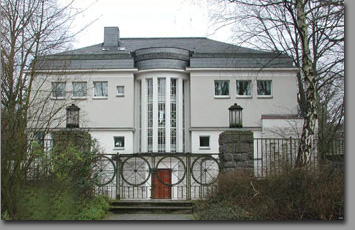| The Hagen Impulse |
| Was ist der Hagener Impuls? | The Hagen Impulse | Guide | Tale |
| BEHRENS VILLAS | Haßleyer Straße 35 | |||
|
|
||||
| For the western sector of the planned residential area "Hohenhagen" the architect Peter Behrens drew up a development plan which had clear axial reference points. The Schröder house, which was the first to be built in 1908/09 and was destroyed in the Second World War, was a two-storey geometrically structured building with a combined living-room/hall on the ground-floor. In 1909/10, Behrens was commissioned by Osthaus to build the residence of the then mayor of Hagen, Willy Cuno, on the awkwardly proportioned, triangular plot at the entrance to the street Am Stirnband. A spiral interior staircase, which rises from the entrance area and is lit by long narrow strips of window, determines the classically austere design of the external façade with its semi-circular central projection. |  |
|
 |
The Cubist construction is
of a severe simplicity; the street façade is only enlivened by the
contrast in materials between the rustic base of undressed stone and the
smooth plaster work of the upper storeys. Walter Gropius collaborated to a
large extent in the construction of the Cuno house as Behrens' assistant.
However, fundamental differences of opinion about the project led to a
split between these two major architects. Nevertheless, Karl Ernst Osthaus
remained in contact with them both. In 1911/12, Behrens finally built the
Goedecke house near to the Cuno house. This is an L-shaped building with a
two-storey living area and single-storey office wing and a terrace laid
out in the angle between the two sections.
Since the main entrance is set in the less representative short side, the true size of the house can only be appreciated from the garden.
|
|